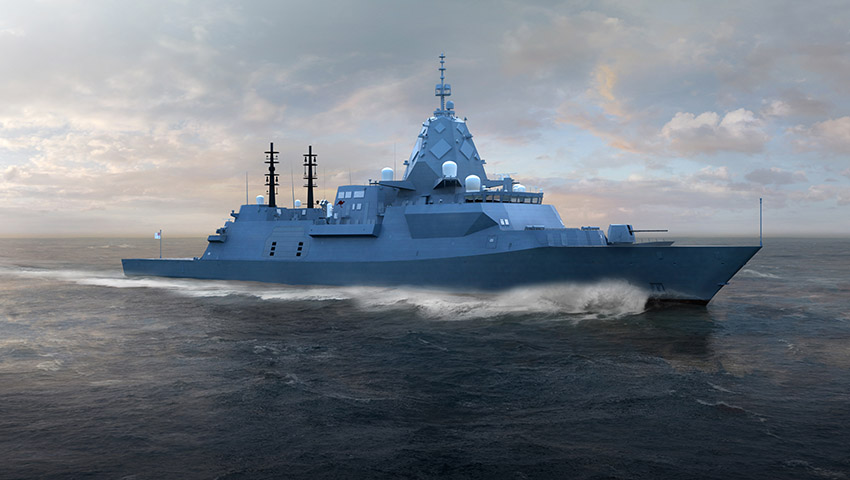Defence Minister Linda Reynolds and Defence Industry Minister Melissa Price have announced that three Australian defence industry firms have been asked to participate in feasibility studies to explore potential opportunities for the local production of materials for the Hunter Class Frigate Program.
ASC Shipbuilding, a subsidiary of BAE Systems Australia, has asked three local defence industry firms to undertake feasibility studies to determine whether they can contribute to the construction of Hunter Class frigates as part of the government’s SEA 5000 Future Frigate program.
The prime contractor has engaged:
- Queensland-based Craig International Ballistics to investigate an Australian solution for ship bridge windows and armour protection;
- Adelaide-based REDARC Defence Systems to explore an Australian solution to LED lighting; and
- Western Australia-based propeller manufacturer VEEM to examine security requirements for local propeller manufacture in Australia.
This forms part of ASC Shipbuilding’s commitment to achieve 58 per cent Australian industry content over the life of the Hunter Class frigate contract.
“With a 30-year life span, the building of nine submarine hunting warships provides an enormous opportunity for the nation to advance our sovereign shipbuilding capability and create long-term prospects for Australian industry,” ASC Shipbuilding managing director Craig Lockhart said.
“I have absolute confidence in Australian industry to bring ingenuity and innovation to the Hunter program, while at the same time providing valuable employment opportunities in the nation’s advanced manufacturing sector at a time when we’ve never needed it more.”
VEEM’s managing director, Mark Miocevich, welcomed the opportunity to participate in the study.
“VEEM operates the most advanced commercial propeller manufacturing facility in the world, and being considered for the manufacture of the new anti-submarine warfare frigates is an exciting proposition,” he said.
“BAE Systems has a long history in defence in Australia and has shown over that time its commitment to supporting Australian industry content across a broad range of programs.”
Mike Hartas, REDARC Defence Systems general manager, sales, acknowledged that while the preliminary contract “does not guarantee work”, it would enable the firm to demonstrate the value of its proposition to the government as it progresses with its National Shipbuilding and Sustainment Plan.
Craig International Ballistics CEO James Craig added: “As a provider of ballistic protection to many Australian Defence Force assets, we welcome the opportunity to showcase our Australian industry capability for the Hunter Class Frigate Program.”
Following the announcement, Defence Minister Linda Reynolds said the feasibility studies build on the Morrison government’s commitment to “maximising Australian industry content” in the construction of the new anti-submarine warfare frigates.
“We are on track to begin the prototyping phase of the Hunter Class Program at the end of this year, which is why it’s vital we continue to form new partnerships with Australian industry as we look ahead to the build phase,” Minister Reynolds said.
“These feasibility studies announced today build on a feasibility study already underway into locally manufactured main reduction gearboxes for future Hunter batches.”
Defence Industry Minister Melissa Price added that the feasibility studies – which are expected to be completed by the end of the year – would ensure Australian companies are given “every chance to contribute” to the broader Naval Shipbuilding Program.
The launch of the feasibility studies comes just days after the ministers announced that ASC Shipbuilding signed a contract with South Australian company Infrabuild Steel Centre to support the manufacturing of the Hunter Class Frigates at the Osborne South shipyard.
The contract is for the supply of around 120 tonnes of Australian steel that will be used to support the manufacturing of the Hunter Class frigates.
In June 2018, the Commonwealth government announced BAE Systems Australia as the successful tender for the $35 billion SEA 5000 Future Frigate program.
The nine Hunter Class frigates will be based on the BAE Systems Type 26 Global Combat Ship currently under construction for the Royal Navy and will replace the eight Anzac Class frigates when they enter service beginning in the late 2020s.
The Hunter Class is billed as an anti-submarine warfare (ASW) centric vessel delivering an advanced ASW capability to the Royal Australian Navy at a time when 50 per cent of the world’s submarines will be operating in the Indo-Pacific region.
BAE Systems Australia announced that it had selected Lockheed Martin Australia and Saab Australia as combat systems integration industry partners, responsible for delivering the Australian designed CEAFAR 2 Active Phased Array Radar, Lockheed Martin-designed Aegis combat management system and Saab Australia 9LV tactical interface.
The $35 billion program sees ASC Shipbuilding become a subsidiary of BAE Systems throughout the build process beginning in 2020 at the Osborne Shipyard in South Australia, creating more than 4,000 jobs.
BAE Systems expects the Australian industry content for the Hunter Class build will be 65-70 per cent, which will create and secure thousands of jobs for decades.
At the end of the program, the Commonwealth will resume complete ownership of ASC Shipbuilding, thereby ensuring the retention in Australia of intellectual property, a highly skilled workforce and the associated equipment.
SEA 5000 is expected to support over 500 Australian businesses who have been pre-qualified to be part of the Hunter Class supply chain, with the Australian steel industry in particular benefiting from the 48,000 tonnes of steel required to build the ships.
[Related: Australian steel to support Hunter Class frigate prototyping]









